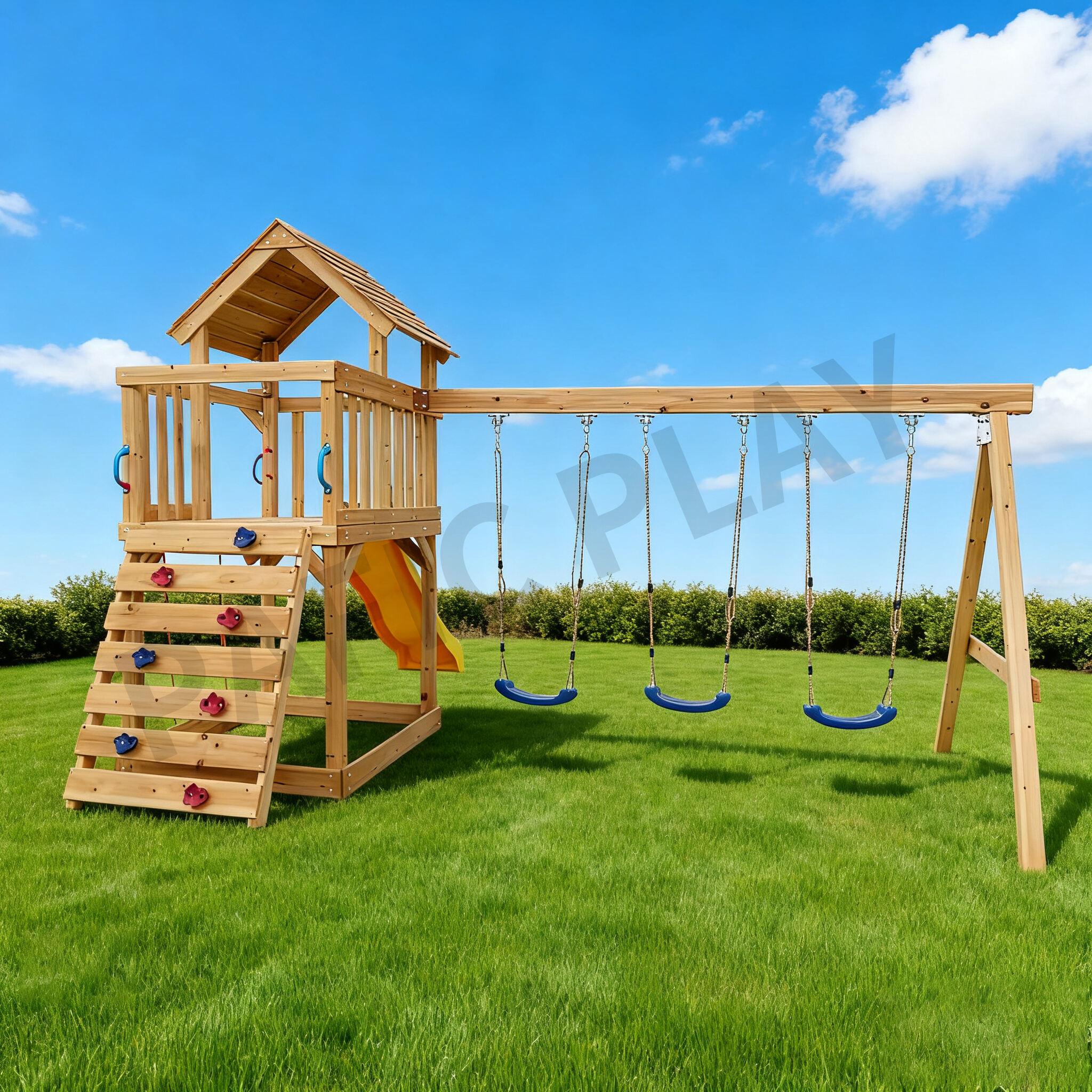Výběr správného venkovní hřiště výběr sad pro školy a parky je klíčové rozhodnutí, které ovlivňuje vývoj dětí, jejich bezpečnost a celkové blaho komunity. Tyto rekreační prostory slouží jako životně důležitá centra, kde mladé myslí rostou prostřednictvím fyzické aktivity a sociální interakce. Vzhledem k rostoucímu důrazu na hru venku a dokumentovaným přínosům pro vývoj dětí vyžaduje výběr vhodného hřídelního vybavení pečlivé zvážení mnoha faktorů.
Moderní venkovní hřiště se výrazně vyvinula od jednoduchých kombinací houpaček a skluzavek z minulosti. Dnešní instalace zahrnují inovativní návrhy, udržitelné materiály a pokročilé bezpečnostní prvky, které vyhovují různým věkovým skupinám a schopnostem. Porozumění těmto prvkům je klíčové pro informovanou investici, která bude sloužit komunitě po mnoho let.
Při výběru venkovních hřištních setů je nezbytné dodržování bezpečnostních norem. Veškeré vybavení by mělo splňovat nebo převyšovat směrnice stanovené Komisí pro bezpečnost spotřebního zboží (CPSC) a organizací ASTM International. Tyto normy upravují klíčové aspekty, jako jsou výšky pádů, tlumení nárazu a správné rozestupy mezi jednotlivými částmi vybavení.
Ověření certifikace zařízení by mělo probíhat prostřednictvím nezávislých zkušebních laboratoří, aby bylo zajištěno, že každá součást splňuje přísné bezpečnostní požadavky. Měly by být také stanoveny pravidelné kontrolní protokoly, které zajistí dodržování předpisů po celou dobu životnosti hřiště.
Různé věkové skupiny vyžadují specifické návrhové úvahy u venkovních hřišť. Oblasti pro batolata by měly mít nižší plošiny, menší schody a zařízení, které podporuje rozvoj základních motorických dovedností. Děti ve školním věku těží z náročnějších prvků, které podporují stavbu síly a koordinaci, přičemž jsou zachována přiměřená bezpečnostní opatření.
Oddělení volných ploch mezi věkově specifickými oblastmi pomáhá předcházet úrazům a zajišťuje, že děti interagují se zařízením vhodným pro jejich vývojové stádium. Správné značení a vizuální signály mohou pomoci rodičům a dozorcům vést děti do příslušných herních zón.

Dlouhověkost venkovních hřišť do značné míry závisí na jejich materiálovém složení. Materiály vyšší třídy, jako je pozinkovaná ocel, kov s práškovým nátěrem a plasty stabilizované proti UV záření, nabízejí vynikající odolnost vůči povětrnostním vlivům. Tyto materiály zabraňují rezivění, vyblednutí a strukturálnímu poškozování i za náročných klimatických podmínek.
Investice do kvalitních materiálů může na počátku představovat vyšší náklady, ale díky nižší potřebě údržby a delší životnosti zařízení přináší významné úspory na dlouhodobé období. Při výběru materiálů vezměte v úvahu místní povětrnostní podmínky, abyste zajistili optimální výkon.
Základem bezpečných venkovních hřišť je jejich strukturní pevnost. Zařízení by měla být navržena tak, aby podporovala současně více uživatelů a zároveň zachovávala stabilitu. Nosné části je třeba pravidelně kontrolovat a měly by být vyrobeny z materiálů odolných proti opotřebení a únavě materiálu.
Profesionální instalace certifikovanými dodavateli zajišťuje správné kotvení a montáž, což je klíčové pro udržení strukturální integrity. Pravidelné údržbové kontroly by měly být zaměřeny na připojovací body, nosné sloupy a oblasti s vysokým namáháním.
Správné provedení povrchu je zásadní pro bezpečnost hřiště a může výrazně snížit riziko zranění. Současné venkovní hřištní sestavy by měly být instalovány nad nárazem pohlcujícími materiály, jako je technicky upravené dřevěné vlákno, gumový mulč nebo litý pryžový povrch. Hloubka těchto materiálů by měla odpovídat výšce zařízení a potenciálním zónám pádu.
Při výběru povrchových materiálů je třeba brát v úvahu schopnost odvodňování, nároky na údržbu a přístupnost pro uživatele s omezenou mobilitou. Pravidelné kontroly hloubky a doplňování materiálu zajišťují stále stejnou úroveň ochrany.
Moderní povrchy hřišť musí umožňovat přístup uživatelům všech schopností. Přes celou hříštní plochu je třeba zajistit přístupné trasy s vhodnými povrchovými materiály, které umožní přístup vozíčkářům a zároveň zachovají vlastnosti tlumení nárazu. Pro podporu inkluzivního hraní by měly být do návrhu začleněny transferové plošiny a rampy.
Volba barvy povrchu může také zvýšit bezpečnost tím, že poskytuje vizuální signály pro různé zóny aktivity a pomáhá identifikovat změny výšky nebo hranice vybavení.
Zavedení komplexního plánu údržby je nezbytné pro venkovní hříštní sady. Denní vizuální kontroly mohou odhalit okamžité bezpečnostní rizika, zatímco měsíční podrobné hodnocení by mělo zkoumat stabilitu konstrukce, stav povrchu a spojovací prvky. Dokumentace těchto kontrol pomáhá sledovat stav vybavení v průběhu času.
Školení zaměstnanců v oblasti správných technik inspekce zajišťuje konzistentní monitorování a včasnou detekci problémů. Vytvoření kontrolního seznamu údržby specifického pro každý typ zařízení pomáhá standardizovat proces inspekce.
Preventivní údržba prodlužuje životnost zařízení a zabraňuje bezpečnostním rizikům. Pravidelné čištění, mazání pohyblivých částí a rychlá výměna opotřebovaných komponentů pomáhají udržet optimální výkon. Úkoly sezónní údržby by měly řešit specifické environmentální výzvy, jako je odstraňování sněhu nebo ochrana před UV zářením.
Vztahy s kvalifikovanými poskytovateli údržby zajišťují rychlou reakci na opravy a přístup k originálním náhradním dílům. Toto partnerství podporuje dlouhodobou udržitelnost investice do hřiště.

Vysoce kvalitní venkovní hřištní sady obvykle vydrží 15 až 20 let, pokud jsou řádně udržovány. Tato doba se však může lišit v závislosti na faktorech, jako je kvalita materiálu, intenzita používání, klimatické podmínky a způsob údržby. Pravidelné kontroly a včasné opravy mohou výrazně prodloužit životnost zařízení.
Požadovaný prostor závisí na vybraném zařízení a požadavcích na bezpečnostní zónu. Obecně každé zařízení vyžaduje volný prostor šest stop na všech stranách, přičemž některé prvky mohou vyžadovat větší plochu. Celková plocha by měla zahrnovat jak aktivní hřídelní zóny, tak cesty pro pohyb mezi jednotlivými zařízeními.
Nezbytné bezpečnostní prvky zahrnují vhodná ochranná zábradlí a bariéry, správné rozestupy mezi jednotlivými součástmi za účelem prevence uvíznutí, zaoblené hrany a rohy, pevné upevňovací prvky a spoje a plochy s tlumením nárazu. Výbava by měla být také vhodná pro daný věk a splňovat všechny současné bezpečnostní normy a směrnice.
 Aktuální novinky
Aktuální novinky2025-10-30
2025-10-30
2025-10-30
2025-10-30
2025-10-30
2025-09-01